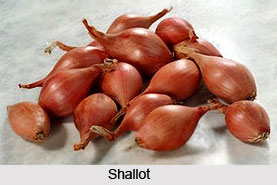 Botanical name: Allium Ascalonicum Linn
Botanical name: Allium Ascalonicum Linn
Family: Liliaceae
Indian names are as follows:
Hindi: Ek-kanda-lasun, Gandana
Bengali: Gundhun
Punjabi: Gandana, Gandhan
Shallots are long, slim, underground, fleshy stems in the Allium family of tunicate bulb vegetables. In general, they differ from the onions in being smaller, and grow in clusters of bulbs from each plant-root system. The bulbs are characteristically less pungent than that of onions and garlic.
Shallots are cool season perennials; however, they can be grown as annual crops just like onions. The plant reaches about 50 cm in height, and bears 1-5 cloves of bulblets just underneath the surface. Shallots are formed more like garlic than onions, with a head composed of multiple cloves, each covered with a thin, papery skin. The skin colour can vary from golden brown to pale grey to rose red, and the off-white flesh is usually barely tinged with green or purple. Like their cousin`s onion and garlic this is also considered as non-vegetarian food in India. Shallots probably originated in Central or Southeast Asia, travelling from there to India and the eastern Mediterranean.
Types of Shallots
The two main types of shallots are the Jersey or "false" shallot (the larger of the two) and the more subtly flavoured "true" shallot. Fresh green shallots are available in the spring, but as with garlic and onions, dry shallots i.e., with dry skins and moist flesh are available year-round. Shallots are favoured for their mild onion flavour and can be used in the same manner as onions.
Cultivation
Shallots are extensively cultivated for culinary uses, propagated by offsets. In some regions, the offsets are usually planted in autumn. In some other regions, the suggested planting time for the principal crop is early spring.
In planting, the tops of the bulbs should be kept a little above ground, and the soil surrounding the bulbs is often drawn away when the roots have taken hold. They come to maturity in summer, although fresh shallots can now be found year-round in supermarkets.
Uses of Shallots in Cooking
The flavour of shallots is somewhat milder than that of onion. The chief use is for flavouring curries; both leaves and cloves are used. Leaves are also consumed as green vegetable. Shallots are used in fresh cooking in addition to being pickled. Finely sliced, deep-fried shallots are used as a condiment in Asian cuisine, often served with porridge. Shallots taste somewhat like a common onion, but have a milder flavor. Like onions and garlic, when sliced, raw shallots release substances that irritate the human eye, resulting in production of tears.
In Indian cuisines, the distinction between onions and shallots is weak; larger varieties of shallot are often confused with small red onions and used interchangeably. Indeed, most parts of India use the regional name for onion interchangeably with shallot. The southern regions of India distinguish shallots from onions in recipes more often, especially the much loved tiny varieties; these are widely used in curries and different types of "sambhar", a lentil-based dish. Shallots pickled in red vinegar are common in many Indian restaurants, served along with sauces and papad on the condiments tray. Indians also use it as a home remedy for sore throats, mixed with jaggery or sugar. In Nepal, shallots are used as one of the ingredients for making "momo". In Kashmir shallots are widely used in preparation of Wazwan Kashmiri cuisine.
Health benefits of Shallots
•Overall, shallots have better nutrition profile than onions. They have more anti-oxidants, minerals, and vitamins than onions.
•They are rich source of flavonoids and anti-oxidants.
•It also has anti-bacterial, anti-viral, and anti-fungal activities.
•Shallots reduce cholesterol and blood pressure.
•It decreases the risk of Coronary Artery Disease (CAD), Peripheral Vascular Diseases (PVD) and stroke.
•The phyto-chemical compounds in shallots protects from cancers.
•Helps lower blood sugar levels in diabetics.
•The herb is applied to cure fever, for relieving earache, and as aphrodisiac.
•They are also used as antidote for snake bite and poisoning.




















